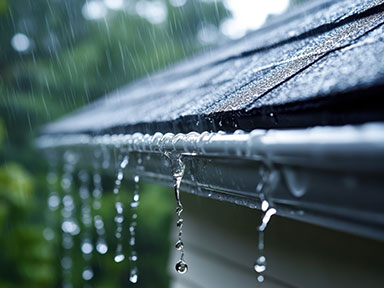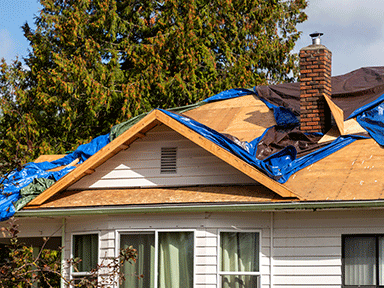Claims for impact damage may not be an everyday thing, but they can and do happen. If your rental property is, quite literally, impacted, you need to know what to do.
We’ve all seen the nightly news with the footage of a vehicle that has wound up in someone’s living room or backyard pool. While it doesn’t happen every day – and not all incidents make the evening news – these sorts of impact accidents can and do happen. And that means they also can and do happen at rental properties.
One memorable EBM RentCover claim followed an incident that occurred one Christmas Day. At around 4pm, a driver lost control of their car, clipped a parked car and then hurtled through a vacant block and two boundary fences before colliding into the back of a rental property. As you can imagine, the property sustained severe damage including to the alfresco area, patio, kitchen, living room and dining area. As the property was deemed uninhabitable, the tenants had to move out while the repairs were made. Between repair costs and loss of rent, the claim totalled $52,000.
As you can see, impact by vehicles, especially when driven at speed, has the potential to cause extensive damage, including structural, to the premises and its surrounds.
Of course, impact damage is not limited to vehicles ploughing into houses. With increasing technology and space exploration, there is a growing risk of spacecraft and space debris falling to Earth. If that falling debris damaged your investment property, you’d be glad there is cover for that impact damage in your landlord insurance policy.
Ditto if there’s damage caused by debris from an aircraft, rocket or satellite. Speaking of satellites, roof-mounted satellites, masts, and television and radio aerials that break or collapse, and cause damage may also be covered.
One of the more common types of impact damage is from falling trees or parts of trees such as branches. While this frequently happens during a storm, it may occur outside of a weather event too. In these cases, the cause of the fall will determine what section of the policy the claim is made under. Falling trees and branches tend to cause damage to roofs, fences and outdoor structures such as sheds, patios and pergolas. During storms, branches may crash through windows and shatter glass doors.
It is important to note that there is no cover for impact damage caused by the felling or lopping of trees or branches at the site, with the contractor likely to be responsible for this damage.
When we talk about impact damage, we are also talking about ‘sudden impact’, not something that has happened gradually like a chimney stack slowly toppling over and damaging the roof.
By its very nature, serious impact damage can be very, well, serious. Vehicles crashing through rooms and trees falling through roofs can cause extensive damage, including risking the structural integrity of the building. In some cases, the property is deemed uninhabitable while repairs are carried out, leading to loss of rent in addition to costly repairs. Luckily, loss of rent may be covered while the property cannot be tenanted during repairs.
So, what should landlords and their property managers do if the rental has suffered impact damage?
The priority should be safety. Ensure the tenants are safe and out of harm’s way. If you are attending the property, follow the instructions of any authority (such as emergency services, utility, or council) on-site and do not enter unless it is safe to do so. If it is safe and permissible to enter the property, review the damage and identify any emergency repairs needed to make the premises safe.
You should also document the damage. Take photos and video with your phone. You will need to submit evidence with your insurance claim.
In some cases, the emergency services may have carried out some actions to make-safe, such as erecting tarps over damaged roof sections or shutting off the power. If this hasn’t been done already, you may need to arrange this. It’s important that you don’t ask your tenants to do anything that puts them at risk (you could be held liable if they hurt themselves) or do anything outside of your own ability.
It is a condition of landlord insurance to act to prevent further loss. This means you will need to make reasonable efforts to try to stop more damage occurring. What this will involve will depend on the circumstances. It could mean covering broken windows or securing damaged areas. It may mean arranging emergency repairs. EBM RentCover policyholders do not need our prior permission to arrange emergency repairs – just keep the tax invoices/receipts to submit with your claim. However, you should avoid making any non-emergency or permanent repairs before the damage has been assessed and approval for repair given.
Once the basics are taken care of – the tenants are safe, and you’ve done what you reasonably could to prevent further loss from occurring – get in touch with your landlord insurance provider. We will guide you through what you need to do to fulfill your obligations under cover and discuss what happens next. Depending on the circumstances and the impact damage sustained, different things will happen, so we will talk you through the process.
Thankfully, serious impact damage isn’t an everyday event, but when it does happen, knowing what to do is important to safeguard your insurance cover. That’s why there’s always a friendly voice on the end of the line when you reach out to a member of our Expert Care team. Please get in touch if you have any questions – 1800 661 662.
*While we have taken care to ensure the information above is true and correct at the time of publication, changes in circumstances and legislation after the displayed date may impact the accuracy of this article. If you need us we are here, contact 1800 661 662 if you have any questions.
You may also like
View all
When a rental suffers damage, some repairs are emergencies and they require urgent fixing. Here are the details...

When rain becomes more of a deluge than a dribble, you need to make sure your rental is prepared...

There is a condition in landlord insurance policies that requires the policyholder to ‘act to prevent further loss’. What does this mean?...




